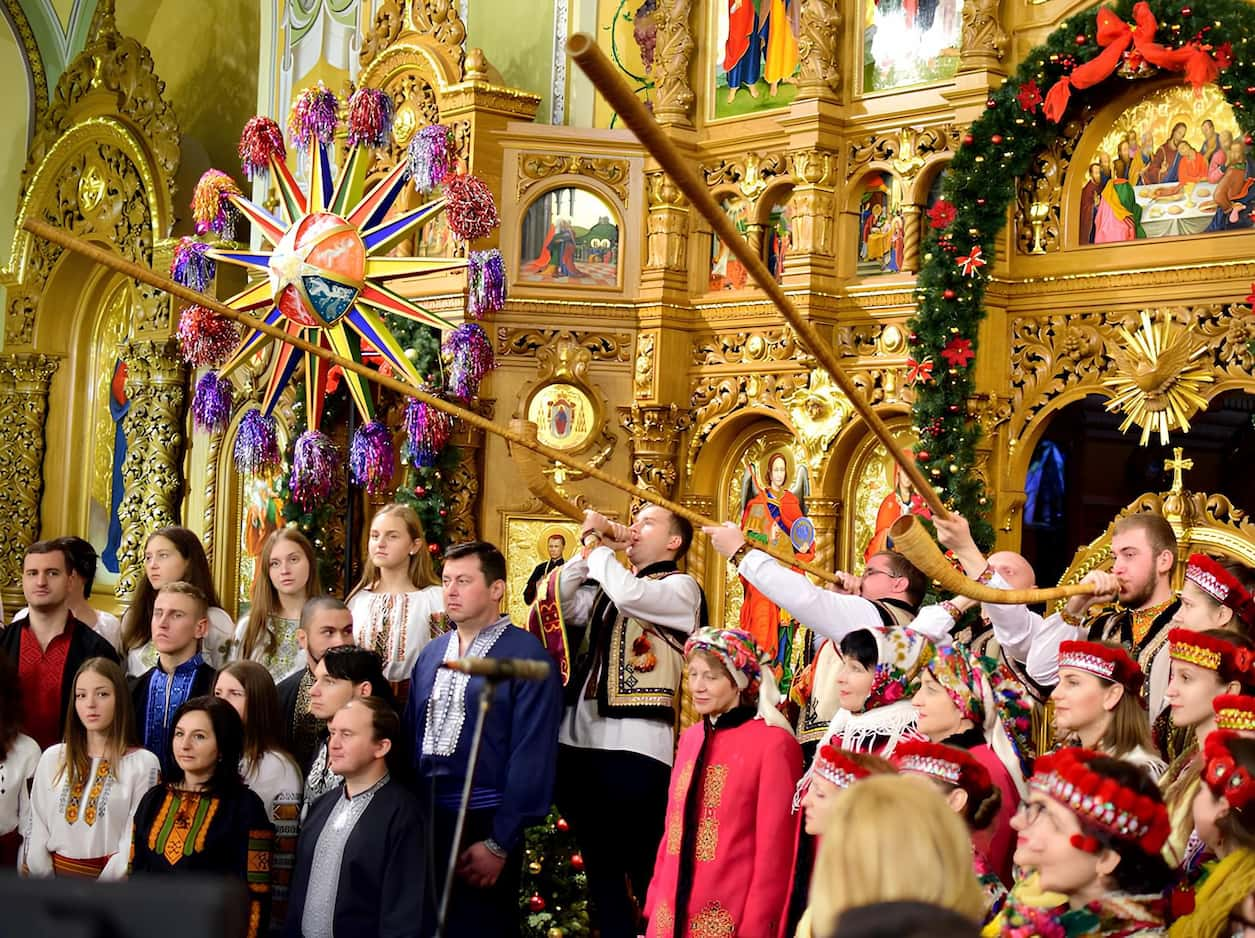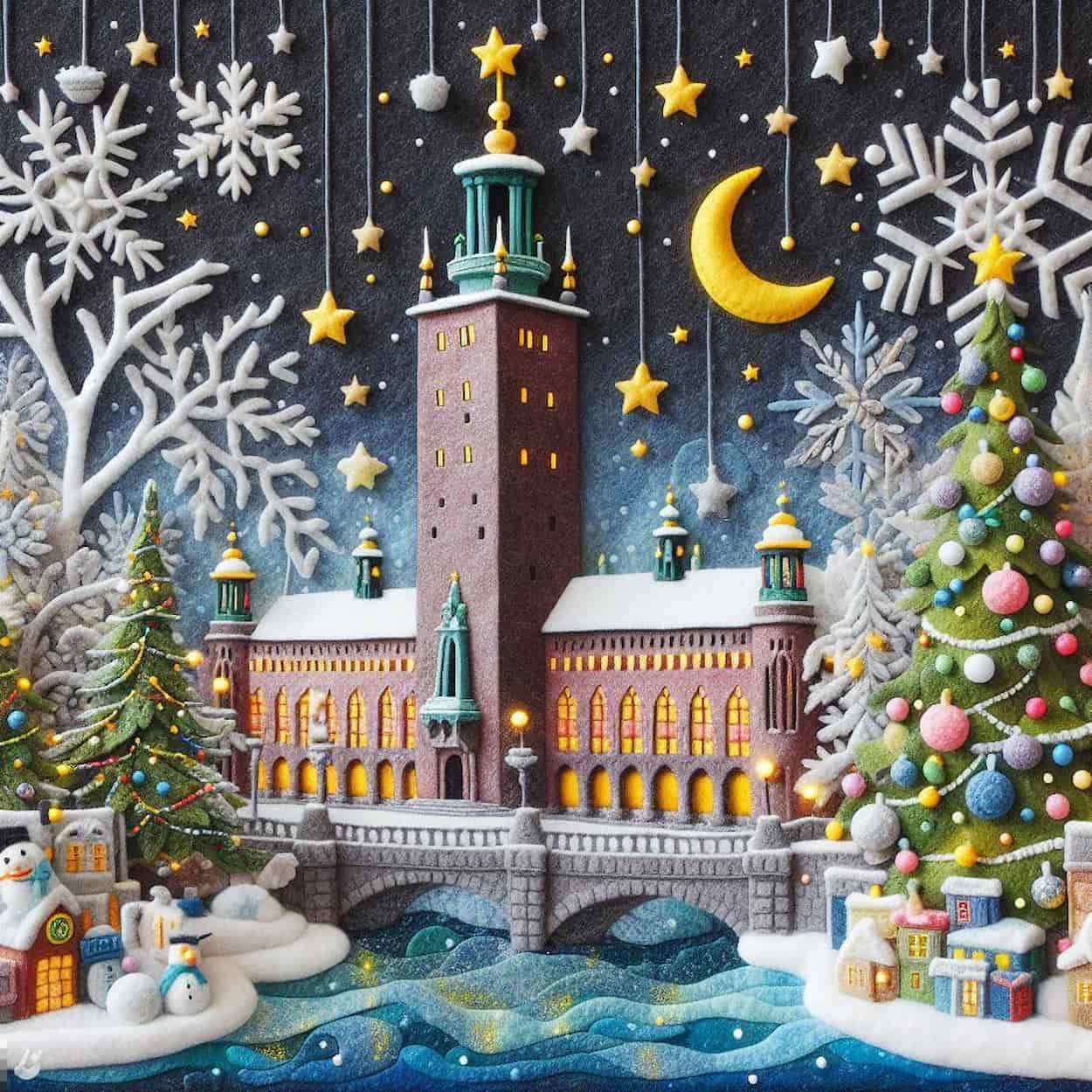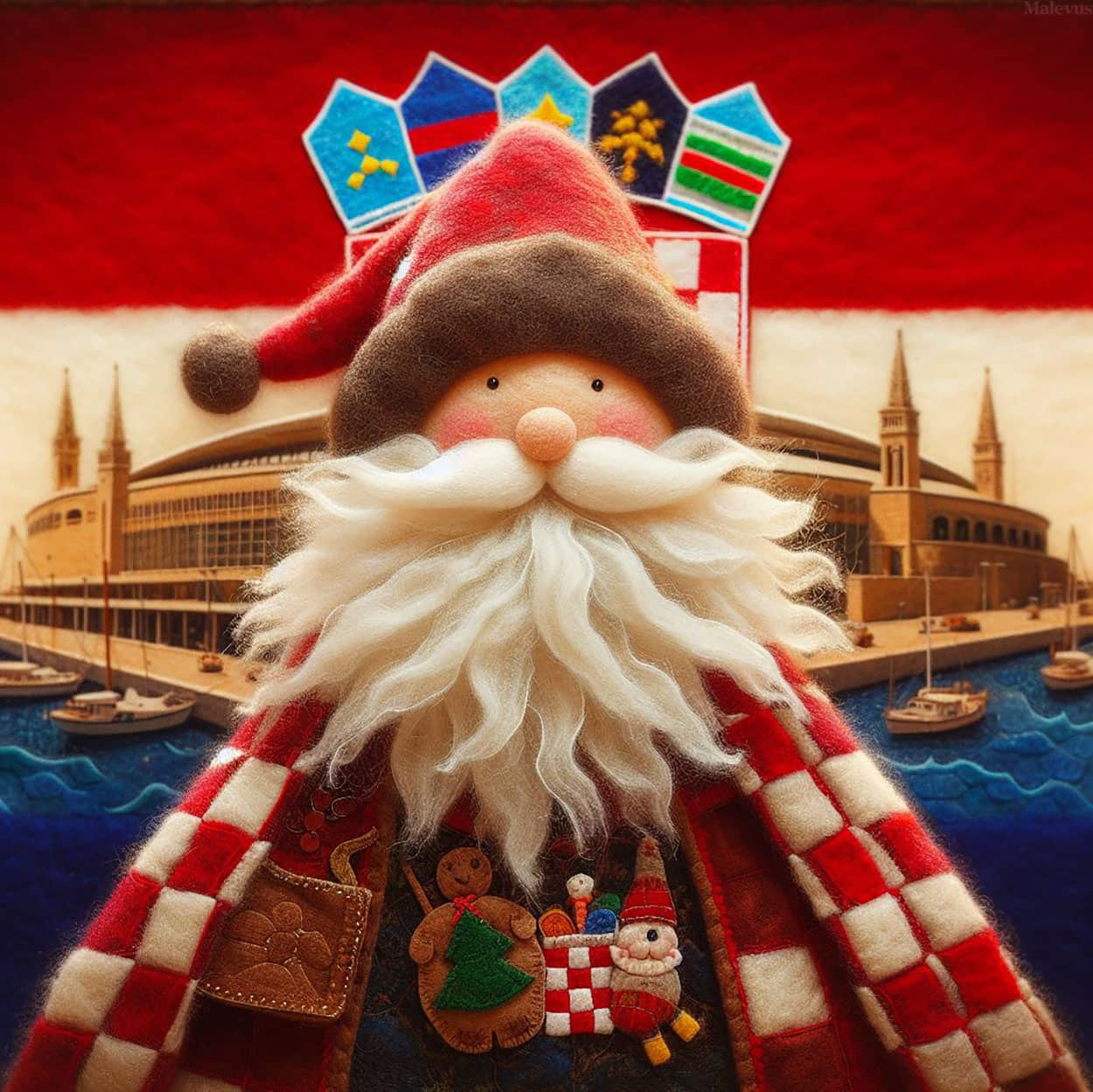The folk-Christian Slavic festival of Koliada is held on the night of December 24th–25th to mark the start of the new year. This festival has its roots in a pagan Slavic celebration of the sun and the arrival of spring. However, the celebration of Christmas on this particular day brought more attention to the person of Jesus Christ and the celebrations, as shown in the Belarusian “Kałyady” and the Lithuanian “Kalėdos”—Christmas.
A shared family meal with fortune-telling was an integral part of the Koliada celebration, as was tending to the home and paying respects to ancestors. After this, members of the family would get presents and go caroling while performing ceremonial scenes. Today, most people associate Koliada with Christmas Eve, when the family gathers for a big meal. Carols eventually became a part of Christmas customs rather than the Koliada celebration.
Celebration of Koliada
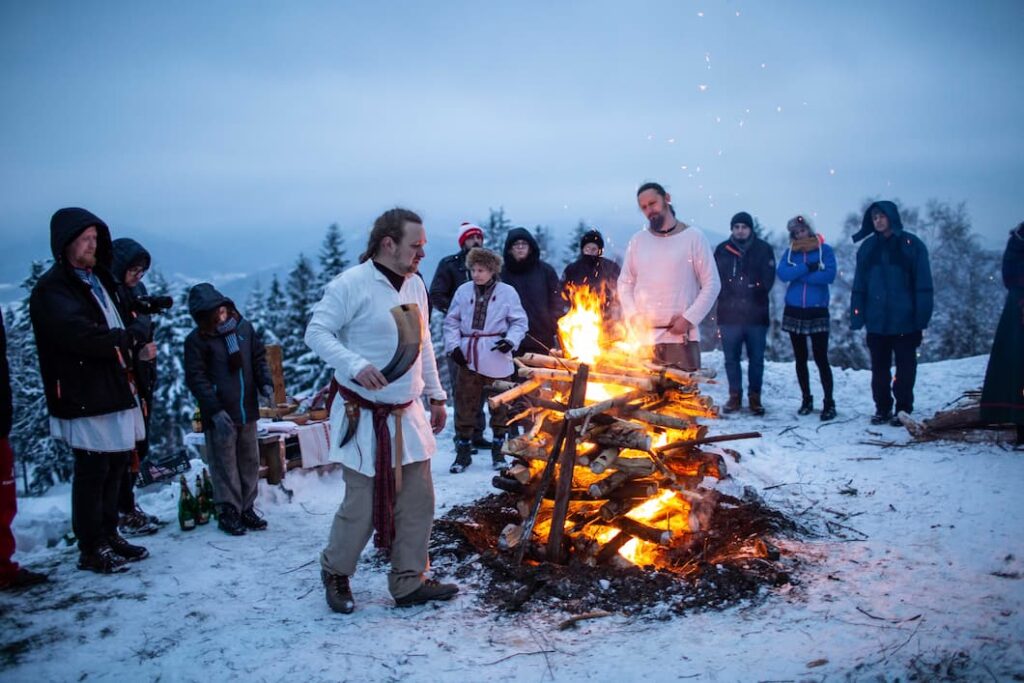
With the arrival of a new year, the Kolyada celebration signifies the rebirth of the universe. As a result, it is accompanied by a plethora of ceremonies meant to cleanse, usher in the new, bring good fortune, and ward off evil. When observed on December 24–25 (in the old form) or January 6-7 (in the Orthodox style), Kolyada is associated with the evening and night before Christmas. House cleaning, wall and partition renewal with white and colored clay, family clothing stitching, and utensil shopping were all rituals that Ukrainians would do before celebrating Kolyada. Even practical goods like “makitra” (a small clay mixing bowl) and “makohin” had to be new. For this festival, supplies of firewood, honey, bread, hay, canvas, and other items had to be made ready in advance.
Using fresh or clean towels and herbs to decorate icons before Christmas is a Christian custom. The practice of decorating walls with floral designs and other symbols continued until the 18th century and found its way into the creation of pysanky, or Easter eggs. Chimneys were adorned with paper figures throughout the 19th century. Those who kept beehives for the purpose of making candles used wax two or three days prior to Christmas. Three “Trinity” candles were produced in the Poltava area, but in other locations, they were manufactured in the days leading up to the Savior’s Feast. Candles in ancient times were solemn means of lighting, and houses were usually lit with “kagantsi” or “skalky” — thin wooden splints. Roles for future caroling were also determined, and girls made wreaths from ivy (as it is evergreen).
The fire for cooking dishes on Kolyada was originally obtained by rubbing one piece of wood against another—the so-called “living fire.” The ritual of obtaining it existed among the Hutsuls in the 19th century. On this evening, livestock had to be fed and combed, and a jug with “holy” items, such as charcoal and holy water, was left in the barn. The final preparation before the feast was the scattering by the host around the house, outside, and in the barn of poppy seeds to ward off evil forces, take care of the livestock, and spread hay on the floor.
Didukh
The main pagan rituals on the eve of Christmas for Ukrainians include bringing a decorated sheaf called Didukh into the house, usually done by the head of the household and his son, along with a shared family dinner known as “Holy Supper.” Didukh, placed in the corner of the room, symbolizes the ancestral protectors of the family known as “dids.” According to beliefs, they visit the living members of the family from December 24 to January 1 each evening, during which no other work should be done except caring for the livestock. The Hutsuls considered the presence of spirits so close that they even blew on the benches before sitting to avoid occupying a spot where someone’s soul might reside.
Koliada Dinner
For the dinner, 12 meatless dishes are prepared (in some regions of Ukraine, 17) representing the months, with the main dish being “rich kutia.” The composition of kutia was meant to showcase the wealth of the household and serve as a sacrifice to the god Veles, hoping for a bountiful harvest in the coming year. Different regions had their own traditional order of serving dishes, each with its own symbolism; for example, honey symbolizes life and poppy seeds represent sleep and death.
Kutia, set aside for the ancestral spirits, was designated to seek their assistance in the upcoming year. The table for the Christmas Eve supper was covered with two tablecloths: the lower one for the ancestors and the upper one for the living. A lit candle was placed in the center of the table on a pole or a thick cake. Right before the feast, the head of the household would recite incantations, varying by region. These incantations could be for inviting the spirits of ancestors, the Sun, the Moon, and the Stars, and warding off evil forces and frost. Traditionally, the dinner took place on communal dishes, and two empty plates were left for the deceased and absent family members.
Celebrations could be accompanied by magical actions aimed at bringing prosperity to the house and preventing misfortunes in the following year: scattering hay, making holes in the benches, imitating the sounds of livestock, domestic birds, and bees, and tossing children in hay. Part of the kutia was given to domestic birds and livestock. Kutia could be used for divination, attempting to predict the prosperity of the household based on its composition. In Poltava, children divined by pulling out random items hidden under the tablecloths, such as a flower or an ear of wheat. The host and hostess could also engage in divination. It was a known custom on the eve of Christmas to invite lonely, homeless individuals for supper.
Caroling During Koliada
After the feast, on what is called “Holy Night,” spirits from both the realms of good and evil mingle with humans. The following day, the custom of caroling begins, with the youngest children singing carols to their immediate families before the older kids go to the homes of complete strangers. In this case, an exception was allowed for a group of youngsters called “polarizers,” who were expected to reflect good spirits by caroling till daylight. The host has an obligation to greet the carolers and give them presents. Both youngsters and adults are familiar with a variety of carols. Carols sung by females receive extra care. Pastures (cows) in Polissia have their own set of songs.
The night following the supper, known as “Holy Night,” is when both good and evil spirits roam among people. The next day, caroling begins, starting with the youngest children singing carols to their relatives and then the older ones going to the homes of strangers. An exception was made for boys known as “polarizers,” who caroled until sunrise and represented good spirits. It is the host’s duty to welcome carolers and reward them with gifts. Various types of carols are known to both children and adults. Special attention is given to girls’ carols. In Polissia (a region Eastern Europe), there are carols specifically for livestock (oxen).
Younger children traditionally perform well-wishing carols, conveying wishes for prosperity and announcing the news of Christmas. In return, they traditionally received kutia, bagels, apples, nuts, and a small coin. The introduction of Christianity made attending church on the first day of Christmas an important part of the celebration. The service lasted from the 12th night to 4 in the morning, or even longer, and until the 19th century, it included singing pre-Christian carols.
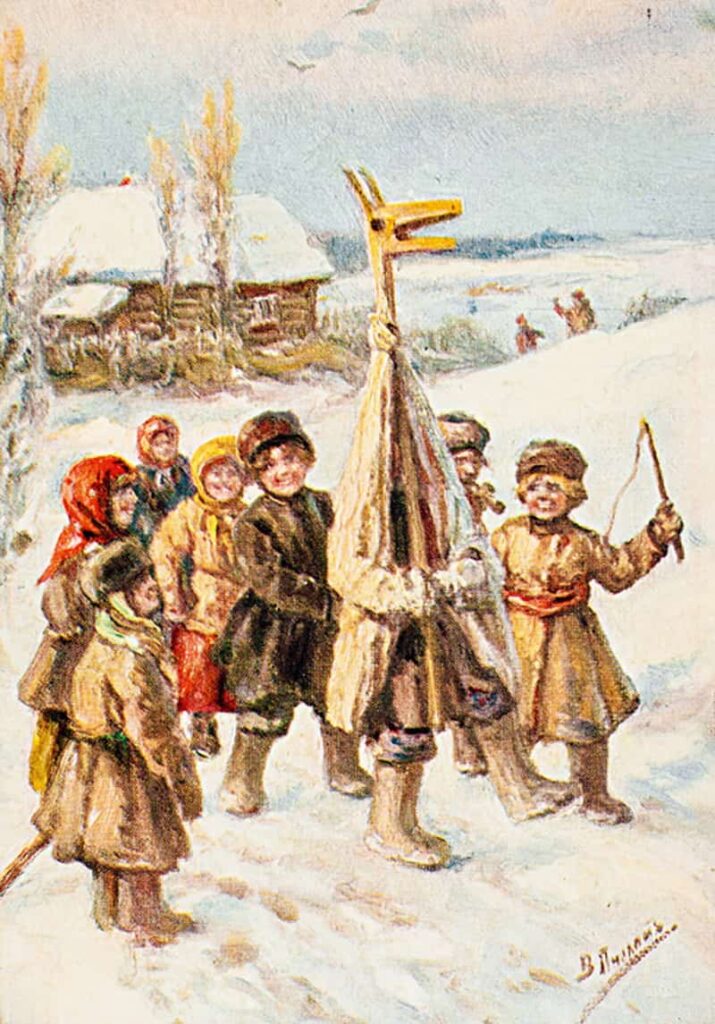
Following a group prayer and breakfast, family members who attended the service welcomed those who stayed at home. Until evening, a peaceful atmosphere prevailed, except for young couples visiting their parents and grandparents. In the evening, the youth started caroling, which continued for 2–3 days. Boys and men caroled for everyone, while girls caroled for other girls and young children. Adult carolers enacted scenes (vertep) that reproduced fertility rituals involving “goat driving” (which is a Christmas tradition of bringing a real goat or a person with a goat mask to houses for treats) as well as scenes related to the episodes of Christ’s birth.
These performances often included references to current events and politics. Among them were biblical characters (Three Kings, King Herod), folklore figures (Death, Devil), and socio-political figures (Gypsy, Butcher, Soldier, Cossack). Vertep performances are known from the 17th and 18th centuries. In Galicia, Volhynia, and some areas of southern Ukraine, they continued until the arrival of the Bolsheviks and were revived after independence.
History of Koliada
In modern-day Ukraine, Kolyada is most often linked with Christmas carols performed throughout the holiday. The Hutsul area (which includes Transcarpathia, Bukovyna, and Galicia) is home to the oldest and most beautifully preserved carols. The religion of the ancestors and the reverence of the newborn sun are two aspects of the celebrations that have endured through the ages, bearing many similarities to their pagan predecessors. Up until the Epiphany on January 19, contemporary caroling was the norm in the majority of Ukraine. But up until around the middle of the past century, carolers in the Kyiv area would visit each home until the feast of the Presentation of the Lord on February 15.
According to folklore research, many Indo-European peoples’ familiarity with the ancient practice of caroling was really a ceremony honoring ancestor spirits known as “Didi.” Various underworld creatures, including pagan gods, spirits that influence or even govern natural occurrences, and human life and death, were said to reside among the “Didi,” who acted as intermediaries between this world and the hereafter.
Accordingly, consulting the spirits of long-dead ancestors was an integral part of every significant ceremony and event in the lives of traditional communities. For a short period of time each year, the “Didi” would make a triumphant return to Earth. This took place at a holy and enigmatic time, just as the solar year was coming to a close and the new one was starting.
Just as the story goes, at the crossroads of time, the “Didi” would visit their living relatives in an effort to bestow blessings and riches onto each household, ensuring that the ensuing year would be fruitful for the common people. It seems that ancient priests and magicians who practiced pagan cults—figures from the “other” world—performed the rite of visiting yards. The “Didi,” as ancient people understood them, were invariably distant old men. Because of this, male-only and bachelor communities started to practice circumferential rites, and the “Bereza” of Ukraine, who was once the main priest, became the new head of the community’s caroling.
In certain parts of the Carpathian Mountains, the practice of male-only caroling is still practiced today, while in others, it takes the form of the “Koza” procession. Carolers’ relationship to the “Didi” spirits necessitated certain outward manifestations, such as a white mask covering their faces, a long beard, and a staff. The “Didi” mirrored the concept of the “other world” in both their attire and their actions.
Carolers wore discarded clothing as a result. “Didi” acted in a very strange and often disgusting way: they would make a racket, steal or smash everything in the house, flip everything upside down, remove and relocate the homeowner’s fence or gates to the next street, and so on. Indeed, the ancestors’ beliefs dictated that the “other world” and its inhabitants had to be diametrically opposed to the living world. Simultaneously, the welfare of the living was dependent on these spirits’ existence. Carolers recited religious canonical passages to a specific tune that played just during this time segment and was never repeated throughout the year. This idea explained their unusually respectful approach to their behavior and appearance.
Old rites were further integrated into the Christian tradition’s traditional celebration of Jesus’ birth as the faith spread. As a result, several Ukrainian carols have scenes where Jesus assists a farmer in plowing his field and where the apostles Peter and Paul lead his herds of cattle and Mary brings lunch, called the “nativity scene.” The majority of Ukrainian regions now include women or girls in their Christmas-New Year yard rounds, reflecting a change in ceremonial emphasis. Also gone are the days of using attributions and ancient ceremonial masks, both of which were rendered meaningless.
Some New Year’s rites (“Goat,” “Malanka”) have evolved from their reliance on archaic representations of “Grandfathers” to more modern and relatable ones. Masks like “Gypsy,” “Soldier,” and “Devil” are part of the Christmas nativity scene today, which is centered on Christian morals and teachings instead of Koliada. It often alludes to both political and religious conspiracies and satirizes them. This practice, which had been dormant due to Soviet influence, flourished after Ukraine gained its independence. For example, in nativity scenes, “devil” was replaced by hooligans, and allegorical images related to current events appeared. The puppet-nativity scene was revived.
The Origins of Koliada
There is a major theory that states the word “koliada” came from Latin; the Proto-Slavic *kolęda is a derivative of Latin Calendae, meaning “calends”; and another version suggests that Greek κάλαvδαι, meaning “calendar,” may have had an intermediate impact. People would sing special songs (caroling) to commemorate the New Year’s “calends” in a highly ceremonial way. This practice persisted even after the birth of Christ, prompting the church to merge the Christmas celebration with the older New Year’s Day. Eventually, Christmas songs replaced those from New Year’s Day. Just as the Romans disseminated their Calendae over Europe, all Slavic names of Koliada have their roots in Greek κάλανδαι.
All Romance, Germanic, and Slavic peoples adopted the name “kalenda” or “calends” for the Christmas season when it was borrowed from ancient Greco-Roman pagan ceremonies. Fortune-telling, greetings, dressing up, and tributes in Christmas can only be understood in light of their pagan Koliada roots, and Christian prayers’ plots found their way into pagan carols meant to welcome the pagan New Year. The two celebrations coexisted and mutually influenced each other.
Persian Roots
Ukrainian folklorist Xenophon Sosenko states that the term “koliada” is said to have originated in Iran and meant either “ready sun” or “sun is here”; the Koliada festival was a time when sacrifices were offered to the Sun god. Tehran has had an impact on Ukraine, according to Professor Yevhen Onatsky’s “Small Ukrainian Encyclopedia.”
Slavic Roots
A few unproven theories place the term’s origin squarely in Slavic languages, arguing that it has a phonetic sound with the word “koliada.” These theories, which may be categorized as “pseudoscientific”, are not covered in the Encyclopedic Dictionary of the Ukrainian Language (ESUM):
- Ukrainian folklorist Matviy Nomys suggested that “koliada” originated from “kolivo” and referred to the process of consuming this food;
- Dmytro Shchepkin derived it from “kol” + “eda,” meaning “food in a circle” or “circle food”;
- P. Bezonsov – from “koloda” (supposedly denoting a burning log around which ancient ancestors sat and performed ritual ceremonies);
- Mykola Kostomarov – from the word “koleso” (wheel), which symbolized the sun, the god of warmth.
Alternative Hypotheses
Professor Stepan Kylymnyk believed that “korochun” (one of the Russian words for Koliada), which means “a holiday of the day that gradually increases while the night decreases,” was the actual source of the term “koliada.” But it’s hard to say for sure where the term “korochun” came from. In his view, the cycle of winter in Ukraine follows a pattern comparable to the cycle of winter holidays in ancient Greece and Rome. To be more precise, these are the “Brumalia” holidays, which take place from November 24th to December 17th in remembrance of Dionysus; “Saturnalia” from December 17th to 24th; and “Voti” from December 24th to January 1st, which corresponds to Koliada and associated celebrations.
Because of the widespread embrace of Christianity, all of the ancient names of holidays—with the exception of Kalita and Korochun—were changed to Christian equivalents. The Christian Church in Russia and Ukraine resisted the influence of pagan customs by giving old names new meanings. The so-called “kalends” have survived the longest in Europe (which was originally the first day of every month in the Roman calendar).
According to the Ukrainian linguist J.B. Rudnyckyj’s dialectological field recordings and notes, 1934–1970 (Arch.133), these winter celebrations may have originated in Asia and made their way to Europe via Greece and Rome. In this place, they picked on European distinctiveness, substance, and philosophy; the holidays of each country took on the personality, outlook, and worldview of that country.
Featured Image: Ivano-Frankivsk Regional State Administration, cc by sa 4.0, cropped.


